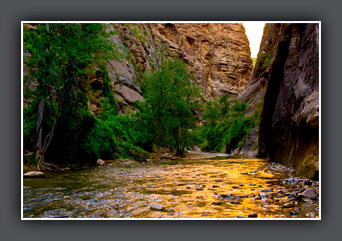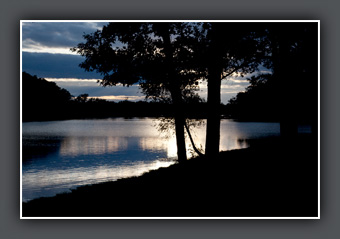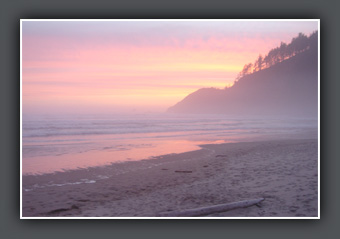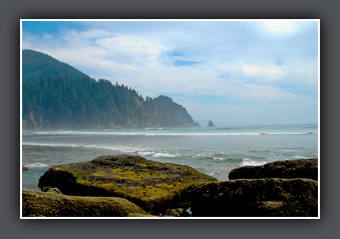Artist’s Statement
My Photographic Journey

I have been deeply interested in Photography since my high school days. Photography
has been an obsessive hobby of mine at least 3 times in my life - but I did not
participate in it steadily throughout that time frame. It wasn’t until I began using
my first digital camera that I was able to see the potential for turning this passion
of mine into more than a hobby. At that time I started collecting images for inclusion
in a future body of work. Each year I added to the collection and the number of
images started growing at an exponential rate.
My passion is nature photography. Stopping to photograph a magnificent mountain
or an ocean scene causes me to slow down and appreciate the extraordinary beauty
this country of ours contains. Macro/close-up photography is an extension of my
interest in nature photography. Getting close to a subject allows me to see things
in ways that I would normally miss. When shooting close up, there can be a world of
beauty in one back yard.
Equipment, Materials and Processes
 I am currently shooting with a Canon 5D Mark III full-frame digital camera with a
variety of Canon L-glass lenses. Many of the images on this site were taken with
previous cameras. I enjoy seeing how far I can push a high-end point-and-shoot
camera, such as the Canon G-series. I shoot all images using the RAW format, which
allows me to capture much more information than JPEG images. (Actually, my
cameras allow me to capture images in both formats, which I take advantage of.)
A typical RAW image is 25 MB, while a typical JPEG image is around 5 MB.
The RAW files give me much more information to work with when preparing images. I am currently shooting with a Canon 5D Mark III full-frame digital camera with a
variety of Canon L-glass lenses. Many of the images on this site were taken with
previous cameras. I enjoy seeing how far I can push a high-end point-and-shoot
camera, such as the Canon G-series. I shoot all images using the RAW format, which
allows me to capture much more information than JPEG images. (Actually, my
cameras allow me to capture images in both formats, which I take advantage of.)
A typical RAW image is 25 MB, while a typical JPEG image is around 5 MB.
The RAW files give me much more information to work with when preparing images.
I print all the images, up to 44”x66”, in my studio using my Epson printers. I currently
have an Epson large format printer (11 different inks) for larger prints and an Epson
mid-size printer (also 11 different inks) for smaller prints. I use only Epson inks and paper
made specifically for these printers. Wilhelm Research, an independent testing
company, has concluded that images made from this combination should last from
70 to 200+ years (depending upon the type of paper used) when stored properly.
For the limited editions, I use only archival materials for anything that touches
the prints – mat board, foam core, backing board, tape, etc. While these methods
add to my costs, they ensure that the images won’t fade quickly nor be ruined by
gases escaping from non-archival materials. As with all photography, prints must be
kept out of direct sunlight and be stored properly, framed behind glass or laminated
using modern photographic lamination processes.
 Post-production storage and processing of my images is done using a variety of
Adobe products: Photoshop, Lightroom, Bridge and Camera Raw. Nothing is added
to my images that was not there to begin with. The only exceptions to this are obvious
and noted – such as the “Growing Guitars” image in the Fun Stuff gallery.
Photoshop is a wonderful tool that allows photographers to squeeze much more out
of their images than was previously possible. It works digitally in the same vein as
film photographers/developers used for decades. I’m convinced that, were
Ansel Adams alive today, he would be a Photoshop freak. Post-production storage and processing of my images is done using a variety of
Adobe products: Photoshop, Lightroom, Bridge and Camera Raw. Nothing is added
to my images that was not there to begin with. The only exceptions to this are obvious
and noted – such as the “Growing Guitars” image in the Fun Stuff gallery.
Photoshop is a wonderful tool that allows photographers to squeeze much more out
of their images than was previously possible. It works digitally in the same vein as
film photographers/developers used for decades. I’m convinced that, were
Ansel Adams alive today, he would be a Photoshop freak.
Limited Editions
Images are available in signed and numbered limited editions of 250. Smaller images
(image sizes
of 6 x 9 and 8 x 12) are not considered part of an edition and thus are not
signed and numbered. These smaller prints are not counted in the 250 limit - a standard
practice of photographers.
Mats, Backing Boards, Frames
 Most non-framed images are sold with mats and either backing boards or foam core backs.
Mats protect
the print from coming in contact with the glass, ensuring longer life of the print.
Smaller images come with an archival quality backing board, rather than foam core backs.
Most standard frames of this size would not have the thickness for foam core backs. Larger
prints (images 12 x 18 and larger) have archival foam core backs. Most non-framed images are sold with mats and either backing boards or foam core backs.
Mats protect
the print from coming in contact with the glass, ensuring longer life of the print.
Smaller images come with an archival quality backing board, rather than foam core backs.
Most standard frames of this size would not have the thickness for foam core backs. Larger
prints (images 12 x 18 and larger) have archival foam core backs.
Most of my images are printed at a 2:3 aspect ratio to take advantage of the maximum aspect
ratio of my camera equipment. Mats purchased with standard frames are not normally cut to
this ratio. I provide the mat to save you from having to purchase mats specifically cut for my
images. My costs and time spent are higher, but, in the long run, providing this saves you
time and expense.
Lamination
In recent years, lamination processes have been developed to enhance the longevity and
viewing pleasure of photographic prints. Prints are laminated onto a variety of materials
that provide stiffness. Laminated prints do not contain mats, as this would interfere with
the laminating process. Laminated prints can be inserted directly into frames without
mats or glass. Prints are much more vivid using this method as there is no glass in front
of the print and there are no reflections. Again, this is a more expensive process, but
the increased vividness and the reduction in weight make it worthwhile. Shipping
possibilities are more open with laminated prints since many photographers refuse
to ship glass, based upon bad experiences. All of my framed limited edition prints
come laminated onto archival foam core (or other archival materials), rather than with glass. The new laminated, non-framed pieces also utilize archival materials. |


